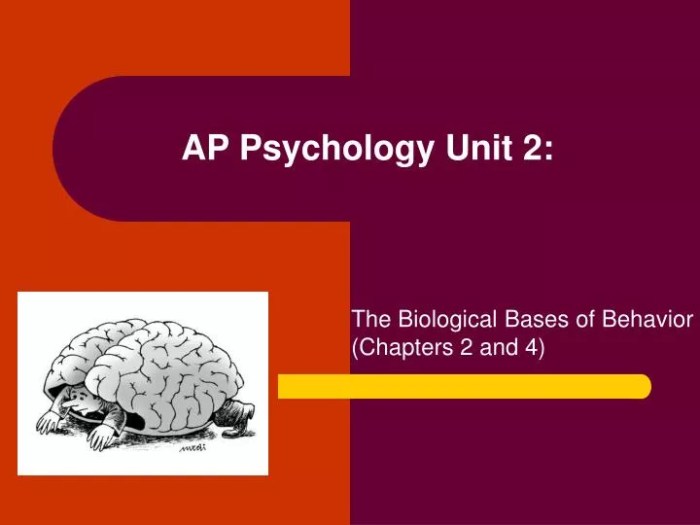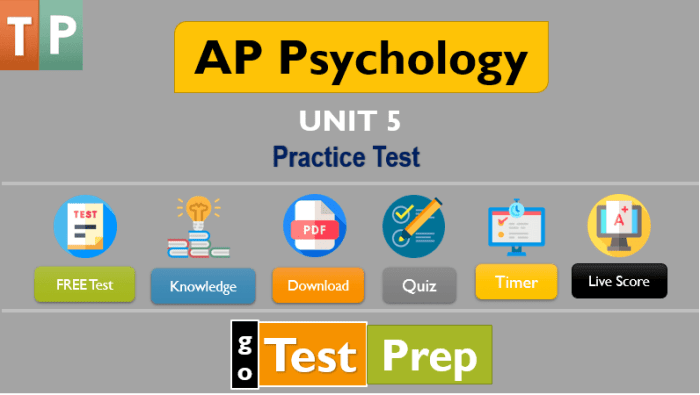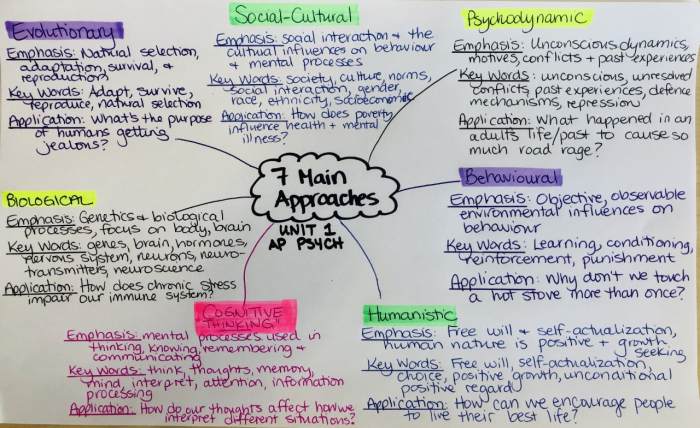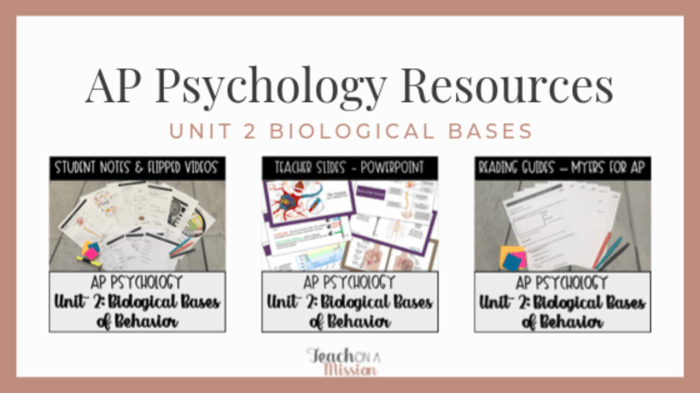AP Psychology Unit 2 Vocabulary: Delving into the fascinating world of psychology, we explore the key concepts, theories, and research methods that shape our understanding of the human mind and behavior.
From the biological underpinnings of behavior to the intricacies of learning, memory, and emotion, this vocabulary will equip you with the essential terminology to navigate the complexities of human psychology.
Key Concepts and Definitions

Psychology is the scientific study of behavior and mental processes. It seeks to understand how people think, feel, and act, and how these processes are influenced by their environment and experiences.
There are many different perspectives in psychology, each of which offers a unique lens through which to view human behavior. The major perspectives include:
Biological Perspective
- Focuses on the role of biological factors, such as genes, brain chemistry, and the nervous system, in shaping behavior and mental processes.
- Examples: Studying the effects of genetics on personality or the impact of brain damage on cognitive function.
Cognitive Perspective
- Focuses on the role of mental processes, such as perception, attention, memory, and problem-solving, in shaping behavior.
- Examples: Studying how people perceive and interpret information or how they solve problems.
Behavioral Perspective
- Focuses on the role of environmental factors, such as reinforcement and punishment, in shaping behavior.
- Examples: Studying how children learn new behaviors through positive reinforcement or how adults change their behavior in response to negative consequences.
Psychological Research
Psychological research is conducted using a variety of methods, including:
- Experiments: Researchers manipulate one or more independent variables to observe the effects on a dependent variable.
- Observational studies: Researchers observe behavior in natural settings or in controlled environments.
- Case studies: Researchers study a single individual or group in depth to gain insights into a particular behavior or mental process.
- Surveys: Researchers collect data from a large sample of people to describe the prevalence of certain behaviors or attitudes.
Research Methods
Psychologists use a variety of research methods to study human behavior and mental processes. These methods can be broadly categorized into three main types: experiments, surveys, and case studies.
Experiments
Experiments are the most controlled type of research method. In an experiment, the researcher manipulates one or more independent variables (the presumed cause) to observe the effect on one or more dependent variables (the presumed effect). This allows the researcher to establish a cause-and-effect relationship between the variables.
Experiments are often conducted in a laboratory setting, where the researcher can control all aspects of the environment. However, experiments can also be conducted in the field, where the researcher observes participants in their natural environment.
Strengths of Experiments
- High level of control, allowing for the establishment of cause-and-effect relationships.
- Can be used to test specific hypotheses.
- Results can be generalized to a wider population.
Weaknesses of Experiments
- Can be artificial and may not reflect real-world behavior.
- Can be time-consuming and expensive to conduct.
- Participants may be aware of the purpose of the study, which can bias the results.
Surveys
Surveys are a type of research method in which participants are asked to answer questions about their thoughts, feelings, or behaviors. Surveys can be conducted in person, by mail, or online.
Surveys are often used to collect data from a large number of people. This can be helpful for getting a general overview of a population’s attitudes or beliefs.
Strengths of Surveys
- Can collect data from a large number of people quickly and easily.
- Can be used to measure a wide range of variables.
- Relatively inexpensive to conduct.
Weaknesses of Surveys
- Can be subject to bias, as participants may not answer questions honestly or accurately.
- Difficult to generalize results to a wider population, as the sample may not be representative.
- May not provide in-depth information about individual participants.
Case Studies
Case studies are a type of research method in which a researcher studies a single individual or a small group of individuals in depth. Case studies can be used to explore a particular phenomenon or to develop a theory.
Case studies are often used to study rare or unusual cases. They can also be used to provide in-depth information about a particular individual or group.
Strengths of Case Studies
- Can provide in-depth information about a particular individual or group.
- Can be used to explore rare or unusual cases.
- Can help to develop theories.
Weaknesses of Case Studies
- Difficult to generalize results to a wider population.
- Can be time-consuming and expensive to conduct.
- May be biased, as the researcher may have a personal connection to the participants.
Biological Bases of Behavior: Ap Psychology Unit 2 Vocab

The biological bases of behavior explore the intricate interplay between our physical structure and our psychological experiences. This vast field delves into the structure and function of the nervous system, the brain’s role in processing information and controlling behavior, and the profound influence of genetics and evolution on shaping our actions.
Structure and Function of the Nervous System
The nervous system is a complex network of specialized cells that transmit information throughout the body. It comprises two main divisions: the central nervous system (CNS), consisting of the brain and spinal cord, and the peripheral nervous system (PNS), which includes all other nerves extending from the CNS to the rest of the body.The
CNS serves as the central processing unit of the nervous system, receiving sensory information, interpreting it, and coordinating appropriate responses. The brain, the most complex organ in the body, is responsible for higher-order functions such as consciousness, thought, emotion, and memory.
The spinal cord, on the other hand, relays information between the brain and the rest of the body.The PNS consists of sensory neurons, which transmit information from the body to the CNS, and motor neurons, which carry commands from the CNS to muscles and glands.
The autonomic nervous system, a division of the PNS, regulates involuntary functions such as heart rate, digestion, and breathing.
Brain Processes and Behavior
The brain, the command center of our being, plays a crucial role in processing information and controlling behavior. It consists of various regions, each with specialized functions. The cerebral cortex, the outermost layer of the brain, is responsible for higher-order cognitive processes such as language, reasoning, and problem-solving.
The limbic system, a group of interconnected structures, is involved in emotion, motivation, and memory. The brainstem, the oldest part of the brain, controls basic life functions such as breathing, heart rate, and sleep-wake cycles.The brain processes information through a complex network of neurons, specialized cells that transmit electrical and chemical signals.
Neurons communicate with each other at synapses, junctions where signals are transmitted from one neuron to another. The brain’s ability to process information and control behavior is dependent on the intricate interplay of these neurons and synapses.
Genetics and Evolution
Genetics and evolution play a significant role in shaping behavior. Our genes, inherited from our parents, provide the blueprint for our physical and psychological traits. Genes influence a wide range of behaviors, from personality characteristics to cognitive abilities.Evolution, the process of gradual change over time, has also shaped our behavior.
Through natural selection, traits that enhance survival and reproduction become more prevalent in a population over generations. This evolutionary process has influenced our social behaviors, mating strategies, and even our susceptibility to certain mental disorders.
Sensation and Perception

Sensation and perception are the processes by which we experience the world around us. Sensation is the process of detecting physical stimuli from the environment, while perception is the process of interpreting and organizing these stimuli into meaningful experiences.
Our sensory systems are specialized to detect different types of stimuli. The visual system detects light, the auditory system detects sound, the somatosensory system detects touch, temperature, and pain, the olfactory system detects odors, and the gustatory system detects tastes.
Once these stimuli are detected, they are sent to the brain, where they are processed and interpreted. The brain uses a variety of cues to help us perceive the world around us, including:
- Size and shape:The size and shape of an object can help us determine its distance from us and its identity.
- Color:The color of an object can help us identify it and determine its properties.
- Motion:The motion of an object can help us determine its speed and direction.
- Sound:The sound of an object can help us identify it and determine its location.
- Smell:The smell of an object can help us identify it and determine its properties.
- Taste:The taste of an object can help us identify it and determine its properties.
The brain uses these cues to create a coherent and meaningful experience of the world around us.
Learning
Learning is the process of acquiring new knowledge, skills, or behaviors through experience or education. It is a fundamental aspect of human development and adaptation to our environment.
There are different types of learning, each with its own unique characteristics and processes:
Classical Conditioning
Classical conditioning is a type of learning where an organism learns to associate a neutral stimulus with a meaningful stimulus, leading to a conditioned response.
- Unconditioned stimulus (US):A stimulus that naturally triggers a response.
- Unconditioned response (UR):The natural response to the unconditioned stimulus.
- Conditioned stimulus (CS):A neutral stimulus that, after being paired with the unconditioned stimulus, eventually triggers a conditioned response.
- Conditioned response (CR):The learned response to the conditioned stimulus.
Operant Conditioning
Operant conditioning is a type of learning where an organism learns to associate its behavior with consequences, leading to an increase or decrease in the likelihood of that behavior.
- Positive reinforcement:A consequence that increases the likelihood of a behavior being repeated.
- Negative reinforcement:A consequence that removes an unpleasant stimulus, increasing the likelihood of a behavior being repeated.
- Punishment:A consequence that decreases the likelihood of a behavior being repeated.
Theories of Learning
There are various theories that attempt to explain the processes of learning:
- Behaviorism:Focuses on observable behaviors and the role of reinforcement and punishment in shaping behavior.
- Cognitivism:Emphasizes the role of mental processes, such as memory, attention, and problem-solving, in learning.
Examples of Learning in Everyday Life
- Learning to drive a car (operant conditioning)
- Developing a fear of spiders (classical conditioning)
- Improving your grades by studying more (operant conditioning)
- Learning a new language (cognitivism)
Memory
Memory is the ability to encode, store, and retrieve information. It allows us to learn from our experiences, remember important events, and navigate our world. There are three main types of memory: sensory memory, short-term memory, and long-term memory.Sensory memory is the brief storage of sensory information, such as sights, sounds, and smells.
It lasts for only a fraction of a second and is used to process and filter incoming sensory information. Short-term memory, also known as working memory, is the temporary storage of information that we are currently using. It lasts for about 20 seconds and is used to hold information in mind while we are working on a task.
Long-term memory is the permanent storage of information that we can recall later. It is divided into two types: explicit memory and implicit memory. Explicit memory is the conscious recall of information, such as facts, events, and names. Implicit memory is the unconscious recall of information, such as skills, habits, and procedures.Theories
of memory attempt to explain how memory works. One of the most influential theories is the multi-store model, which proposes that memory is stored in three separate stores: sensory memory, short-term memory, and long-term memory. Information is transferred from one store to the next through a process of encoding, storage, and retrieval.There
are several things we can do to improve our memory. These include:
- Paying attention to information
- Rehearsing information
- Organizing information
- Using mnemonic devices
- Getting enough sleep
- Eating a healthy diet
- Exercising regularly
Motivation and Emotion
Motivation and emotion are two closely intertwined psychological processes that drive our behavior. Motivation refers to the internal forces that push us to act, while emotion refers to the subjective feelings and physiological responses that accompany our actions.
Theories of Motivation
There are several theories that attempt to explain the mechanisms underlying motivation. One prominent theory is drive theory, which posits that motivation arises from physiological needs, such as hunger or thirst. As these needs increase, so does the drive to satisfy them.
Another theory, incentive theory, suggests that motivation is driven by external rewards or incentives. When we anticipate a positive outcome from a particular action, we are more likely to engage in that action.
Types of Emotions
Emotions are typically classified into two categories: basic emotions and complex emotions.
When you’re prepping for the AP Psychology Unit 2 vocab, don’t forget to check out the USPS Exam 421 Study Guide for additional insights. This guide provides a comprehensive review of the key concepts covered in Unit 2, making it an invaluable resource for your exam preparation.
By incorporating the guide into your study routine, you’ll enhance your understanding of the material and boost your confidence on test day.
- Basic emotionsare innate and universal, and include emotions such as happiness, sadness, anger, fear, and disgust.
- Complex emotionsare learned and are typically more specific and nuanced than basic emotions. Examples include guilt, shame, pride, and gratitude.
Influence of Motivation and Emotion on Behavior
Motivation and emotion have a profound impact on our behavior. Motivation drives us to pursue goals, while emotions can influence our choices and actions. For example, a person who is motivated to achieve success may be more likely to work hard and persevere in the face of challenges.
Similarly, a person who is experiencing anger may be more likely to engage in aggressive behavior.
Development

Human development is a complex process that encompasses physical, cognitive, emotional, and social changes from conception to adulthood. It involves the interaction of genetic and environmental factors that shape an individual’s development throughout their life.
Stages of Human Development
Human development is typically divided into several distinct stages:
- Infancy:From birth to approximately 18 months. Characterized by rapid physical growth, cognitive development, and the formation of attachment bonds.
- Early childhood:From 18 months to approximately 6 years. Marked by significant cognitive and language development, as well as the emergence of self-awareness and social skills.
- Middle childhood:From 6 to approximately 11 years. Children develop physically, cognitively, and emotionally, becoming more independent and mastering new skills.
- Adolescence:From approximately 11 to 18 years. A period of rapid physical, cognitive, and emotional changes, including the development of sexual maturity and the search for identity.
- Early adulthood:From approximately 18 to 30 years. Individuals establish their independence, develop intimate relationships, and begin their careers.
- Middle adulthood:From approximately 30 to 60 years. People typically experience stability in their careers and relationships, and may become more reflective about their lives.
- Late adulthood:From approximately 60 years onward. Physical and cognitive abilities may decline, but individuals often experience increased wisdom and emotional well-being.
Theories of Development
Several theories attempt to explain the mechanisms and processes involved in human development. Some prominent theories include:
- Piaget’s Theory of Cognitive Development:Piaget proposed that children’s cognitive development progresses through a series of stages, each characterized by different ways of thinking and understanding the world.
- Vygotsky’s Sociocultural Theory:Vygotsky emphasized the role of social and cultural factors in cognitive development. He believed that children learn through interactions with others, and that their development is shaped by the cultural context in which they live.
- Erikson’s Theory of Psychosocial Development:Erikson proposed that individuals progress through a series of psychosocial stages throughout their lives, each involving a unique conflict that must be resolved.
Factors Influencing Development
Both genetic and environmental factors play significant roles in human development. Genetics influence physical traits, personality, and certain cognitive abilities. Environmental factors, such as family, culture, and education, also have a profound impact on development. The interaction between these factors shapes an individual’s developmental trajectory.
Personality
Personality refers to the enduring patterns of thoughts, feelings, and behaviors that characterize an individual. It encompasses the unique combination of traits, motives, and mechanisms that influence how people interact with their environment.The study of personality has a long history, with various theories emerging to explain its development and structure.
One prominent theory is trait theory, which posits that personality is composed of a set of stable and enduring traits that remain relatively consistent over time. These traits can be measured using personality inventories, such as the Big Five Inventory, which assesses openness to experience, conscientiousness, extraversion, agreeableness, and neuroticism.Another
influential theory is psychodynamic theory, which focuses on the role of unconscious processes in shaping personality. According to psychodynamic theory, personality is formed during childhood through interactions with significant others, and early experiences can have a lasting impact on an individual’s thoughts, feelings, and behaviors.
Types of Personality Disorders
Personality disorders are characterized by inflexible and maladaptive patterns of behavior that cause significant distress or impairment in an individual’s life. The Diagnostic and Statistical Manual of Mental Disorders (DSM-5) classifies personality disorders into three clusters:
- Cluster A: Odd or Eccentric Behaviors (e.g., paranoid personality disorder, schizoid personality disorder)
- Cluster B: Dramatic, Emotional, or Erratic Behaviors (e.g., antisocial personality disorder, borderline personality disorder)
- Cluster C: Anxious or Fearful Behaviors (e.g., avoidant personality disorder, dependent personality disorder)
Factors that Influence Personality
Personality is influenced by a complex interplay of genetic and environmental factors.
- Genetics:Studies have shown that certain personality traits, such as extroversion and neuroticism, have a genetic basis. However, genes do not fully determine personality, as environmental factors also play a significant role.
- Environment:The environment in which an individual grows up can have a profound impact on their personality. Factors such as parenting style, peer relationships, and cultural influences can shape an individual’s beliefs, values, and behaviors.
Understanding personality is essential for psychologists, as it provides insights into an individual’s behavior, motivations, and relationships. Personality theories and assessments can be used in clinical settings to diagnose and treat mental health disorders, and in educational and occupational settings to enhance self-awareness and improve performance.
Social Psychology
Social psychology explores how our thoughts, feelings, and behaviors are influenced by the presence of others. It delves into the dynamics of social interactions, examining how we perceive ourselves and others, and how these perceptions shape our social behavior.
Theories of Social Psychology
Various theories attempt to explain the complexities of social psychology. One prominent theory is social cognitive theory, which posits that our behavior is influenced by our thoughts, beliefs, and expectations, as well as our observations of others’ behaviors.
Another influential theory is social identity theory, which suggests that our self-concept is shaped by our membership in various social groups. Our behavior, in turn, is influenced by our desire to maintain a positive self-concept and a sense of belonging within these groups.
Types of Social Groups
Social groups can be categorized into different types. Primary groupsare small, intimate groups where members have close, personal relationships, such as family or friends. Secondary groups, on the other hand, are larger, more impersonal groups that are typically formed for a specific purpose, such as a workplace or a sports team.
Factors Influencing Social Behavior, Ap psychology unit 2 vocab
Our social behavior is influenced by a multitude of factors. Cultureplays a significant role, shaping our values, beliefs, and norms. Social norms, or unwritten rules that govern behavior within a society, also exert a strong influence on our actions. Additionally, our personal experiencesand individual characteristicscan shape how we interact with others in social settings.
Helpful Answers
What are the major perspectives in psychology?
The major perspectives in psychology include the biological, cognitive, behavioral, and psychodynamic perspectives.
How do psychologists conduct research?
Psychologists conduct research using a variety of methods, including experiments, surveys, case studies, and naturalistic observation.
What are the different types of learning?
The different types of learning include classical conditioning, operant conditioning, and social learning.